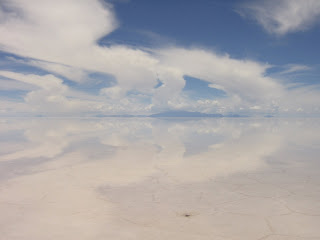 Even the most exotic tourist destinations in the world have a hint of the familiar - the Grand Canyon is just a very big hole in the ground, The Great Wall of China is simply a wall, just a very very long one, and Tannadice is only a football stadium, it just happnes to be a rather magical one.
Even the most exotic tourist destinations in the world have a hint of the familiar - the Grand Canyon is just a very big hole in the ground, The Great Wall of China is simply a wall, just a very very long one, and Tannadice is only a football stadium, it just happnes to be a rather magical one.So there was something extra-ordinarily fascinating and moving about my visit to the unique and unfamiliar site of the Saler de Uyuni, Bolivia´s giant salt flats.
Neither words nor pictures can fully capture the place, but having made that cop-out, the following will try to do some justice to the experience.
The Saler de Uyuni is 10 billion tonnes of salt, covering 12,000 sq kms of the Bolivian altiplano. For most of the year, the salt flat is an immense expanse of blinding whiteness, but in the rainy season the salt flats become an endless perfectly reflecting mirror producing the incredible reflections seen in these images.
 From the edge of the salt-flat a drive into the centre becomes an increasingly eerie and unnerving adventure. The chalk white surface at the edge of the salt flat appears to change colour as you head towards the centre, taking on a pale blue colour, until you realise that this blue is the reflected blue of the sky.
From the edge of the salt-flat a drive into the centre becomes an increasingly eerie and unnerving adventure. The chalk white surface at the edge of the salt flat appears to change colour as you head towards the centre, taking on a pale blue colour, until you realise that this blue is the reflected blue of the sky.
It took us about two hours by pick-up to get to the middle of the salt flat. The distances are so immense and the ground so profoundly flat that after a while it appeared that we were simply floating in space, going nowhere.
Every tourist´s destination on the flats is the Isla de Pescadores (Island of Fishermen). This is an outstandingly beatiful and unlikely place - just a couple of square kms of land in the middle of nothing, like a single lily in a giant frozen pond. There´s nothing cold about this place though, as the island´s inhabitants - thousands of exuberantly bushy cacti - testify.

Close inspection of the salt flat shows it is made up of billions of hexagonal salt ´tiles´. As well as their aesthetic beauty, these tiles represent a commercial bounty for the local people - 20,000 tonnes of salt are harvested from the flats each year.
A closer inspection of the flats also reveals the opportunity for some trick photography. Here I am pushing over a giant pre-Incan statue found sitting on the salt flats.





















